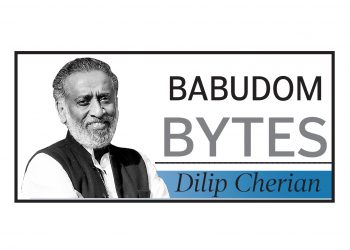The annual conference of principal secretaries of states and union territories held recently had one theme that overrode other discussions on administration and administrative reforms-related work.
Union Minister of State for Personnel Jitendra Singh asked the states to spare more IAS, IPS and IFoS officers for Central deputation, which has become a major issue in recent months. And as 2024 approaches, the Modi sarkar is hastening to address gaps in governance. Singh is now trying to urge babus to overcome their reluctance to serve at the Centre. The Union government has been facing a shortage of IAS officers and to tide over the crisis, it even tweaked the rules in 2021, which stated that state government permission is not necessary for a posting at the Centre. But clearly, that carrot has not worked, with even babus from the BJP-ruled states, preferring to keep their distance from Delhi. Meanwhile, reportedly, the Centre has to confront a shortage of 1,472 IAS officers and 864 IPS officers.
Clearly, the periodic pep talks and admonitions by Prime Minister Narendra Modi and Singh to the babus have failed to dispel the perception in the states and UTs that a Central posting is desirable for upward career mobility. Until the Centre solves this conundrum, it will continue to suffer from deputation blues.
Show your face: AP to senior babus
Fingerprint scanning is passe. Facial recognition is now the next step in recognising the identity of employees. The Andhra Pradesh government has reportedly made facial attendance mandatory for senior IAS officers of the state. Those in the secretary rank and work in the state Secretariat may soon be required to face a camera and mark their attendance.
Sources have informed DKB that the Jagan Reddy government has prescribed this new standard operating procedure to mark the daily attendance of the secretary, principal secretary and special chief secretary-rank IAS officers. As far as DKB can tell, while fingerprint scanning is prevalent in some states, this is a first-of-its-kind system for senior babus in the country. The government has bought a facial recognition system mobile application with geographical information system tagging to mark the daily attendance of these very senior babus. For now, this system has been implemented in the Secretariat, but it will soon be rolled out to cover other IAS officers as well.
Apparently, the system has been in the works for more than a year, sources say. Chief Secretary Sameer Sharma has been issuing frequent instructions, on the directions of Chief Minister Jagan Reddy, asking special chief secretaries, principal secretaries and secretaries of all departments to “get organized and make things effective.”
Intrusive or just sensible? And what next, some wonder. Iris scanners?
Low-key but powerful
Even if it is not formally mandated, Narendra Modi’s PMO is the focal point, controlling all decision-making of the Modi sarkar. Even the ministries have either conceded their domain or the PMO has simply overridden their decision-making authority, in most cases. Naturally, the men and women who comprise today’s PMO invite a lot of interest.
For those who want to know how the Prime Minister manages to look at so many decisions on a continuous basis, perhaps a look at the structure below the Big Three is the obvious thing to do. While many of the high-profile names who made waves during Modi’s first tenure have moved out of the PMO, the current lot carefully handpicked by Modi now spearheads his flagship programmes and lends their expertise to their given responsibilities.
At the top of this select group is PK Mishra, now Principal Secretary to the PM, who has continued his association with the PM since the Gujarat days and accompanied Modi to the PMO in 2014. Besides him, two other senior advisors in the PMO are retired IAS officers Amit Khare and Tarun Kapoor. Besides them are four additional secretaries, three joint secretaries, two private secretaries, 10 directors and four officers on special duty, drawn from all services including the IAS, IPS, IFS and IRS. Interestingly, there is one woman officer Punya Salila Srivastava, who was inducted last year. She oversees social and welfare programmes and is in charge of the various announcements made by the PM. It is this team that Modi relies on most for the implementation of government policy. It is these low-profile babus who are pulling the strings behind the scenes.
Share a babu experience! Follow dilipthecherian@twitter.com. Let’s multiply the effect
